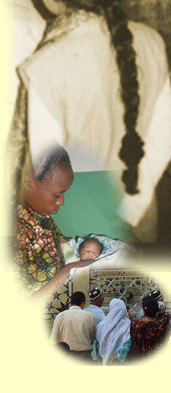The PRIME II Project integrated HIV/AIDS prevention and management with family planning and
other reproductive health care, centering on the preparation and support of primary providers. PRIME
worked to increase the number of providers prepared to confront the challenges of delivering quality
family planning and HIV services in a variety of clinic and non-clinic settings, and assisted program
decision-makers, managers and supervisors to better coordinate their activities.
With PRIME’s extensive field experience in implementing sustainable safe motherhood programs
throughout the developing world, the Project increasingly became involved in designing
interventions to help providers in the prevention of mother-to-child transmission (PMTCT) of HIV.
Building on PMTCT work in Rwanda, PRIME was an implementing partner
in the Presidential Initiative PMTCT program in Ethiopia and developed a methodology and tools that other PMTCT
initiatives can use to maximize opportunities to integrate family planning as an important aspect of
PMTCT.
In a number of countries—from the Philippines to Uganda—PRIME pilot projects succeeded in improving young
peoples’ access to HIV/AIDS prevention services by creating or promoting adolescent-friendly
health care environments. PRIME’s approaches in HIV/AIDS also included:
- Combining dual protection with strategies to overcome provider and client biases against
condom use
- Improving access to information about client needs and gender
sensitivity, including effective, practical social risk assessment and risk reduction counseling
along with the care of people with HIV/AIDS
- Improving access to information,
counseling and services that protect privacy and confidentiality.
Throughout all
of its HIV/AIDS-related activities, PRIME II endeavored to change misconceptions about how HIV is
spread and eliminate stigma associated with condom use. Gender issues, including male involvement and
female empowerment in skills to negotiate condom use with partners, were cornerstones of PRIME’s
strategy in working with communities. Cooperating with a wide variety of organizations involved in
public awareness campaigns, social marketing and other behavior change activities related to HIV/AIDS
was a proven strength of PRIME II.
|











